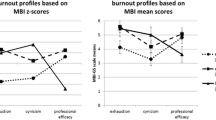Abstract
We examined racial differences in burnout among case managers working with people with severe mental illness, using the Maslach Burnout Inventory. Compared to Caucasians, African Americans reported significantly less Emotional Exhaustion and Depersonalization, but did not differ on levels of Personal Accomplishment. These differences could not be explained by geographic location or perceptions of the work environment; however, age accounted for group differences in Depersonalization. Racial incongruence with caseload appeared to be one factor in burnout, particularly for Emotional Exhaustion. Race of both staff and clients may be important to consider in understanding staff burnout.
Similar content being viewed by others

References
Blank, M. B., Tetrick, F. L., Brinkley, D. F., Smith, H. O., & Doheny, V. (1994). Racial matching and service utilization among seriously mentally ill consumers in the rural south. Community Mental Health Journal, 30, 271–281.
Bond, G. R., Salyers, M. P., & Fekete, D. M. (1996). Illinois Assertive Community Treatment Project Final Report. Unpublished manuscript. Department of Psychology, Indiana University Purdue University Indianapolis.
Bond, G. R., Witheridge, T. F., Dincin, J., Wasmer, D., Webb, J., & De Graaf-Kaser, R. (1990). Assertive community treatment for frequent users of psychiatric hospitals in a large city: A controlled study. American Journal of Community Psychology, 18, 865–891.
Boyer, S. L., & Bond, G. R. (1999). Does assertive community treatment reduce burnout? A comparison with traditional case management. Mental Health Services Research, 1, 31–45.
Carney, J., Donovan, R., Yurdin, M., Starr, R., Pernell-Arnold, A., & Bromberg, E. M. (1993). Incidence of burnout among New York City intensive case managers: Summary of findings. Psychosocial Rehabilitation Journal, 16(4), 25–38.
Cohen, J. (1992). A power primer. Psychological Bulletin, 112, 155–159.
Connell, C.M., & Gibson, G. D. (1997). Racial, ethnic, and cultural differences in dementia caregiving: Review and analysis. The Gerontologist, 37, 355–364.
Cordes, C. L., & Dougherty, T. W. (1993). A review and an integration of research on job burnout. Academy of Management Review, 18, 621–656.
Finch, E. S., & Krantz, S. R. (1991). Low burnout in a high-stress setting: A study of staff adaptation at Fountain House. Psychosocial Rehabilitation Journal, 14(3), 15–26.
Haley, W.E., Roth, D.L., Coleton, M. I., Ford, G. R., West, C. A. C., Collins, R. P., & Isobe, T. L. (1996). Appraisal, coping, and social support as mediators of well-being in black and white family caregivers of patients with Alzheimer's disease. Journal of Consulting and Clinical Psychology, 64, 121–129.
Kirk, S. A., Koeske, G. F., & Koeske, R. D. (1993). Changes in health and job attitudes of case managers providing intensive services. Hospital and Community Psychiatry, 44, 168–173.
Latimer, E. (1999). Economic impacts of assertive community treatment: A review of the literature. Canadian Journal of Psychiatry, 44, 443–454.
Lee, R. T., & Ashforth, B. E. (1996). A meta-analytic examination of the correlates of the three dimensions of burnout. Journal of Applied Psychology, 81, 123–133.
Leiter, M. P., & Maslach, C. (1988). The impact of interpersonal environment on burnout and organizational commitment. Journal of Organizational Behavior, 9, 297–308.
Maslach, C. (1978). The client role in staff burn-out. Journal of Social Issues, 34, 111–124.
Maslach, C. (1993). Burnout: A multidimensional perspective. In W. B. Schaufeli, C. Maslach, & Marek, T. (Eds.), Professional burnout: Recent developments in theory and research (pp. 19–32). Washington, DC: Taylor & Francis.
Maslach, C., & Jackson, S. E. (1986). The Maslach Burnout Inventory. Palo Alto, CA: Consulting Psychologists Press.
Moos, R. H. (1986). Work Environment Scale Manual (2nd Ed). Palo Alto, CA: Consulting Psychologists Press.
Mueser, K. T., Bond, G. R., Drake, R. E., & Resnick, S. G. (1998). Models of community care for severe mental illness: A review of research on case management. Schizophrenia Bulletin, 24, 37–74.
Orlandi, M. A., Weston, R., & Epstein, L. G. (Eds.). (1992). Cultural competence for evaluators: A guide for alcohol and other drug abuse prevention practitioners working with ethnic/racial communities. Washington, DC: U.S. Government Printing Office.
Pickett, S. A., Vraniak, D. A., Cook, J. A., & Cohler, B. J. (1993). Strength in adversity: Blacks bear burden better than whites. Professional Psychology: Research and Practice, 24, 460–467.
Schulz, R., Greenley, J. R., & Brown, R. (1995). Organization, management, and client effects on staff burnout. Journal of Health and Social Behavior, 36, 333–345.
Snowden, L. R., Hu, T., & Jerrell, J. M. (1995). Emergency care avoidance: Ethnic matching and participation in minority-serving programs. Community Mental Health Journal, 31, 463–473.
Teague, G. B., Bond, G. R., & Drake, R. E. (1998). Program fidelity in assertive community treatment: Development and use of a measure. American Journal of Orthopsychiatry, 68(2), 216–232.
Test, M. A., & Stein, L. I. (1976). Practical guidelines for the community treatment of markedly impaired patients. Community Mental Health Journal, 12, 72–82.
Turner, H. A., & Catania, J. A. (1997). Informal caregiving to persons with AIDS in the United States: Caregiver burden among central cities residents eighteen to forty-nine years old. American Journal of Community Psychology, 25, 35–59.
Valentine, D.P., McDermott, S., & Anderson, D. (1998). Mothers of adults with mental retardation: Is race a factor in perceptions of burdens and gratifications? Families in Society, 79, 577–584.
Witheridge, T. F., & Dincin, J. (1985). The Bridge: An assertive outreach program in an urban setting. New Directions for Mental Health Services, 26, 65–76.
Witheridge, T. F., Dincin, J., & Appleby, L. (1982). Working with the most frequent recidivists: A total team approach to assertive resource management. Psychosocial Rehabilitation Journal, 5(1), 9–11.
Author information
Authors and Affiliations
Rights and permissions
About this article
Cite this article
Salyers, M.P., Bond, G.R. An Exploratory Analysis of Racial Factors in Staff Burnout Among Assertive Community Treatment Workers. Community Ment Health J 37, 393–404 (2001). https://doi.org/10.1023/A:1017575912288
Issue Date:
DOI: https://doi.org/10.1023/A:1017575912288



